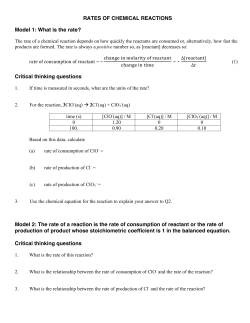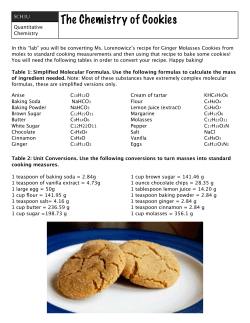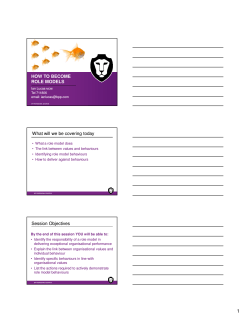
Limiting Reactants CHEMFILE MINI-GUIDE TO PROBLEM SOLVING Name
Name Date Class CHEMFILE MINI-GUIDE TO PROBLEM SOLVING CHAPTER 9 Limiting Reactants At the beginning of Chapter 8, a comparison was made between solving stoichiometry problems and making turkey sandwiches. Look at the sandwich recipe once more. 2 bread slices ⫹ 2 turkey slices ⫹ 1 lettuce leaf ⫹ 1 cheese slice : 1 turkey-and-cheese sandwich If you have 24 slices of turkey, you can make 12 sandwiches at 2 slices per sandwich if you have enough of all the other ingredients. If, however, you have only 16 slices of bread, you can make only 8 sandwiches, even though you may an ample supply of the other ingredients. The bread is the limiting ingredient that prevents you from making more than 8 sandwiches. The same idea applies to chemical reactions. Look at a reaction used to generate hydrogen gas in the laboratory. Zn(s) ⫹ H2SO4(aq) : ZnSO4(aq) ⫹ H2(g) The balanced equation tells you that 1 mol Zn reacts with 1 mol H2SO4 to produce 1 mol ZnSO2 and 1 mol H2 . Suppose you have 1 mol Zn and 5 mol H2SO4 . What will happen, and what will you get? Only 1 mol of H2SO4 will react and only 1 mol of each of the products will be produced because only 1 mol Zn is available to react. In this situation, zinc is the limiting reactant. When it is used up the reaction stops even though more H2SO4 is available. It is difficult to directly observe molar amounts of reactants as they are used up. It is much easier to determine when a certain mass of a reactant has been completely used. Use molar masses to restate the equation in terms of mass, as follows: 65.39 g Zn ⫹ 98.09 g H2SO4 : 161.46 g ZnSO4 ⫹ 2.02 g H2 This version of the equation tells you that zinc and sulfuric acid will always react in a mass ratio of 65.39 g of Zn : 98.09 g of H2SO4 or 0.667 g of Zn : 1.000 g of H2SO4 . If you have 65.39 g of Zn but only 87.55 g of H2SO4 , you will not be able to make 2.02 g of hydrogen. Sulfuric acid will be the limiting reactant, preventing the zinc from reacting completely. Suppose you place 20 g of zinc and 100 g of sulfuric acid into a flask. Which would be used up first. In other words, is the limiting reactant zinc or sulfuric acid? How much of each product will be produced? The sample problems in this chapter will show you how to answer these questions. 1 of 9 Name Date Class CHEMFILE MINI-GUIDE TO PROBLEM SOLVING General Plan for Solving Limiting Reactant Problems 1A 1B Mass of reactant A available Convert using the molar mass of A. 2A Mass of reactant B available Convert using the molar mass of B. 2B Amount of reactant A in mol available Amount of reactant B in mol available Convert using the mole B ratio, . A 3 Amount of reactant B needed to react with A If there are more moles of B available than needed, A is the limiting reactant. If there are fewer moles of B than needed, B is the limiting reactant. 4 Limiting Reactant Convert using the mole ratio, product . limiting reactant 6 Mass of product Convert using the molar mass of the product. 2 of 9 5 Amount of product in mol Name Date Class CHEMFILE MINI-GUIDE TO PROBLEM SOLVING SAMPLE PROBLEM 1 Calcium hydroxide, used to neutralize acid spills, reacts with hydrochloric acid according to the following equation: Ca(OH)2 ⴙ 2HCl B CaCl2 ⴙ 2H2O If you have spilled 6.3 mol of HCl and put 2.8 mol of Ca(OH)2 on it, which substance is the limiting reactant? SOLUTION 1. ANALYZE • What is given in the problem? • What are you asked to find? the balanced equation, the amounts of Ca(OH)2 and HCl in moles the limiting reactant Items Data Reactant Ca(OH)2 HCl Coefficient in balanced equation 1 2 Molar mass NA* NA Amount of reactant 2.8 mol 6.3 mol Mass of reactant NA NA Limiting reactant ? ? * not applicable to the problem 2. PLAN • What steps are needed to determine the limiting reactant? Choose one of the reactants. Use the mole ratio between the two reactants to compute the amount of the other reactant that would be needed to react with it. Compare that amount with the amount available. 2A 2B Amount of Ca(OH)2 in mol Amount of HCl in mol multiply by mole ratio HCl Ca(OH)2 3 Amount of HCl needed to react with Ca(OH)2 compare moles of HCl needed with moles of HCl available 3 of 9 4 Limiting reactant Name Date Class CHEMFILE MINI-GUIDE TO PROBLEM SOLVING Choose one of the reactants, for instance, Ca(OH)2 mole ratio given 2 mol HCl ⫽ mol HCl needed mol Ca(OH)2 ⫻ 1 mol Ca(OH)2 3. COMPUTE 2.8 mol Ca(OH)2 ⫻ 2 mol HCl ⫽ 5.6 mol HCl needed 1 mol Ca(OH)2 The computation shows that more HCl (6.3 mol) is available than is needed (5.6 mol) to react with the 2.8 mol Ca(OH)2 available. Therefore, HCl is present in excess, making Ca(OH)2 the limiting reactant. 4. EVALUATE • Is the answer reasonable? Yes; you can see that 6.3 mol HCl is more than is needed to react with 2.8 mol Ca(OH)2 . PRACTICE 1. Aluminum oxidizes according to the following equation: 4Al ⫹ 3O2 : 2Al2O3 Powdered Al (0.048 mol) is placed into a container containing 0.030 mol O2 . What is the limiting reactant? ans: O2 SAMPLE PROBLEM 2 Chlorine can replace bromine in bromide compounds forming a chloride compound and elemental bromine. The following equation is an example of this reaction. 2KBr(aq) ⴙ Cl2(aq) B 2KCl(aq) ⴙ Br2(l) When 0.855 g of Cl2 and 3.205 g of KBr are mixed in solution, which is the limiting reactant? How many grams of Br2 are formed? SOLUTION 1. ANALYZE • What is given in the problem? • What are you asked to find? the balanced equation, and the masses of Cl2 and KBr available which reactant is limiting, and the mass of Br2 produced 4 of 9 Name Date Class CHEMFILE MINI-GUIDE TO PROBLEM SOLVING Items Data Substance KBr Cl2 Br2 Coefficient in balanced equation 2 1 1 Molar mass* 119.00 g/mol 70.90 g/mol 159.80 g/mol Amount of substance ? mol ? mol ? mol Mass of substance 3.205 g 0.855 g ?g Limiting reactant ? ? NA * determined from the periodic table 2. PLAN • What steps are needed to determine the limiting reactant? • What steps are needed to determine the mass of Br2 produced in the reaction? Convert mass of each reactant to amount in moles. Choose one of the reactants. Compute the amount of the other reactant needed. Compare that with the amount available. Use amount of the limiting reactant and the mole ratio given in the equation to determine the amount of Br2 . Convert the amount of Br2 to the mass of Br2 using the molar mass. 1a 1b Mass of KBr in g Mass of Cl2 in g multiply by the inverse molar mass of KBr multiply by the inverse molar mass of Cl2 2a 2b Amount of KBr in mol Amount of Cl2 in mol multiply by mole ratio: Cl2 KBr 3 compare moles of reactant needed with moles of needed reactant available Amount of Cl2 to react with KBr 4 Limiting reactant multiply moles of limiting reactant Br2 by mole ratio: limiting reactant 6 5 Mass of Br2 in g Amount of Br2 in mol multiply by the molar mass of Br2 5 of 9 Name Date Class CHEMFILE MINI-GUIDE TO PROBLEM SOLVING 1 molar mass KBr given g KBr ⫻ given 1 mol KBr ⫽ mol KBr 119.00 g KBr 1 molar mass Cl2 1 mol Cl2 ⫽ mol Cl2 70.90 g Cl2 Choose one of the reactants, KBr for instance. g Cl2 ⫻ mole ratio calculated above 1 mol Cl2 mol KBr ⫻ ⫽ mol Cl2 needed 1 mol KBr Determine the limiting reactant. mole ratio calculated above molar mass Br2 mol Br2 159.80 g Br2 ⫽ g Br2 mol limiting reactant ⫻ ⫻ mol limiting reactant 1 mol Br2 3. COMPUTE 1 mol KBr ⫽ 0.02693 mol KBr 119.00 g KBr 1 mol Cl2 ⫽ 0.0121 mol Cl2 0.855 g Cl2 ⫻ 70.90 g Cl2 3.205 g KBr ⫻ Choose one of the reactants, KBr, for instance. 0.02693 mol KBr ⫻ 1 mol Cl2 ⫽ 0.01346 mol Cl2 needed 2 mol KBr Only 0.0121 mol Cl2 is available. For all of the KBr to react, 0.0136 mol Cl2 is needed. Therefore, Cl2 is the limiting reactant. 0.0121 mol Cl2 ⫻ 1mol Br2 159.80 g Br2 ⫻ ⫽ 1.93 g Br2 1 mol Cl2 1 mol Br2 4. EVALUATE • Is the determination of limiting reactant reasonable? • Are the units and significant figures of the mass of Br2 correct? Yes; the mass of 2 mol KBr is 238 g and the mass of 1 mol Cl2 is about 71 g, so they react in roughly a 3 : 1 ratio by mass. 3.2 g KBr would require about 1 g of Cl2 , but only 0.855 g is available. The number of significant figures is correct because the mass of Cl2 was given to three significant figures. Units cancel to give grams of Br2 . 6 of 9 Name Date Class CHEMFILE MINI-GUIDE TO PROBLEM SOLVING PRACTICE 1. A process by which zirconium metal can be produced from the mineral zirconium(IV) orthosilicate, ZrSiO4 , starts by reacting it with chlorine gas to form zirconium(IV) chloride. ZrSiO4 ⫹ 2Cl2 : ZrCl4 ⫹ SiO2 ⫹ O2 What mass of ZrCl4 can be produced if 862 g of ZrSiO4 and 950. g of Cl2 are available? You must first determine the ans: ZrSiO4 limiting reactant. 1.10 ⫻ 103 g ZrCl4 ADDITIONAL PROBLEMS 1. Heating zinc sulfide in the presence of oxygen yields the following: ZnS ⫹ O2 : ZnO ⫹ SO2 If 1.72 mol of ZnS is heated in the presence of 3.04 mol of O2 , which reactant will be used up? Balance the equation first. 2. Use the following equation for the oxidation of aluminum in the following problems. 4Al ⫹ 3O2 : 2Al2O3 a. Which reactant is limiting if 0.32 mol Al and 0.26 mol O2 are available? b. How many moles of Al2O3 are formed from the reaction of 6.38 ⫻ 10⫺3 mol of O2 and 9.15 ⫻ 10⫺3 mol of Al? c. If 3.17 g of Al and 2.55 g of O2 are available, which reactant is limiting? 3. In the production of copper from ore containing copper(II) sulfide, the ore is first roasted to change it to the oxide according to the following equation: 2CuS ⫹ 3O2 : 2CuO ⫹ 2SO2 a. If 100 g of CuS and 56 g of O2 are available, which reactant is limiting? b. What mass of CuO can be formed from the reaction of 18.7 g of CuS and 12.0 g of O2? 4. A reaction such as the one shown here is often used to demonstrate a single replacement reaction. 3CuSO4(aq) ⫹ 2Fe(s) : 3Cu(s) ⫹ Fe2(SO4)3(aq) If you place 0.092 mol of iron filings in a solution containing 0.158 mol of CuSO4, what is the limiting reactant? How many moles of Cu will be formed? 7 of 9 Name Date Class CHEMFILE MINI-GUIDE TO PROBLEM SOLVING 5. In the reaction BaCO3 ⫹ 2HNO3 : Ba(NO3)2 ⫹ CO2 ⫹ H2O, what mass of Ba(NO3)2 can be formed by combining 55 g BaCO3 and 26 g HNO3? 6. Bromine replaces iodine in magnesium iodide by the following process: MgI2 ⫹ Br2 : MgBr2 ⫹ I2 a. Which is the excess reactant when 560 g of MgI2 and 360 g of Br2 react, and what mass remains? b. What mass of I2 is formed in the same process? 7. Nickel replaces silver from silver nitrate in solution according to the following equation: 2AgNO3 ⫹ Ni : 2Ag ⫹ Ni(NO3)2 a. If you have 22.9 g of Ni and 112 g of AgNO3 , which reactant is in excess? b. What mass of nickel(II) nitrate would be produced given the quantities above? 8. Carbon disulfide, CS2 , is an important industrial substance. Its fumes can burn explosively in air to form sulfur dioxide and carbon dioxide. CS2(g) ⫹ O2(g) : SO2(g) ⫹ CO2(g) If 1.60 mol of CS2 burns with 5.60 mol of O2 , how many moles of the excess reactant will still be present when the reaction is over? 9. Although poisonous, mercury compounds were once used to kill bacteria in wounds and on the skin. One was called “ammoniated mercury” and is made from mercury(II) chloride according to the following equation: HgCl2(aq) ⫹ 2NH3(aq) : Hg(NH2)Cl(s) ⫹ NH4Cl(aq) a. What mass of Hg(NH2)Cl could be produced from 0.91 g of HgCl2 assuming plenty of ammonia is available? b. What mass of Hg(NH2)Cl could be produced from 0.91 g of HgCl2 and 0.15 g of NH3 in solution? 10. Aluminum chips are sometimes added to sodium hydroxide-based drain cleaners because they react to generate hydrogen gas which bubbles and helps loosen material in the drain. The equation follows. Al(s) ⫹ NaOH(aq) ⫹ H2O(l) : NaAlO2(aq) ⫹ H2(g) a. Balance the equation. b. How many moles of H2 can be generated from 0.57 mol Al and 0.37 mol NaOH in excess water? c. Which reactant should be limiting in order for the mixture to be most effective as a drain cleaner? Explain your choice. 8 of 9 Name Date Class CHEMFILE MINI-GUIDE TO PROBLEM SOLVING 11. Copper is changed to copper(II) ions by nitric acid according to the following equation: 4HNO3 ⫹ Cu : Cu(NO3)2 ⫹ 2NO2 ⫹ 2H2O a. How many moles each of HNO3 and Cu must react in order to produce 0.0845 mol of NO2? b. If 5.94 g of Cu and 23.23 g of HNO3 are combined, which reactant is in excess? 12. One industrial process for producing nitric acid begins with the following reaction: 4NH3 ⫹ 5O2 : 4NO ⫹ 6H2O a. If 2.90 mol NH3 and 3.75 mol O2 are available, how many moles of each product are formed? b. Which reactant is limiting if 4.20 ⫻ 104 g of NH3 and 1.31 ⫻ 105 g of O2 are available? c. What mass of NO is formed in the reaction of 869 kg of NH3 and 2480 kg O2? 13. Acetaldehyde CH3CHO is manufactured by the reaction of ethanol with copper(II) oxide according to the following equation: CH3CH2OH ⫹ CuO : CH3CHO ⫹ H2O ⫹ Cu What mass of acetaldehyde can be produced by the reaction between 620 g of ethanol and 1020 g of CuO? What mass of which reactant will be left over? 14. Hydrogen bromide can be produced by a reaction among bromine, sulfur dioxide, and water as follows. SO2 ⫹ Br2 ⫹ H2O : 2HBr ⫹ H2SO4 If 250 g of SO2 and 650 g of Br2 react in the presence of excess water, What mass of HBr will be formed? 15. Sulfur dioxide can be produced in the laboratory by the reaction of hydrochloric acid and a sulfite salt such as sodium sulfite. Na2SO3 ⫹ 2HCl : 2NaCl ⫹ SO2 ⫹ H2O What mass of SO2 can be made from 25.0 g of Na2SO3 and 22.0 g of HCl? 16. The rare-earth metal terbium is produced from terbium(III) fluoride and calcium metal by the following single replacement reaction: 2TbF3 ⫹ 3Ca : 3CaF2 ⫹ 2Tb a. Given 27.5 g of TbF3 and 6.96 g of Ca, how many grams of terbium could be produced? b. How many grams of the excess reactant is left over? 9 of 9
© Copyright 2025












